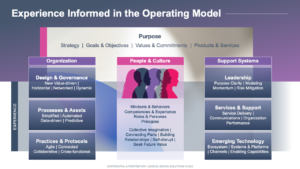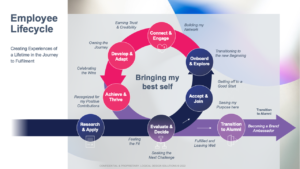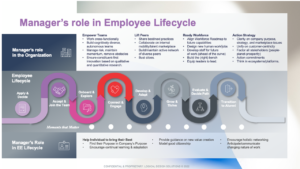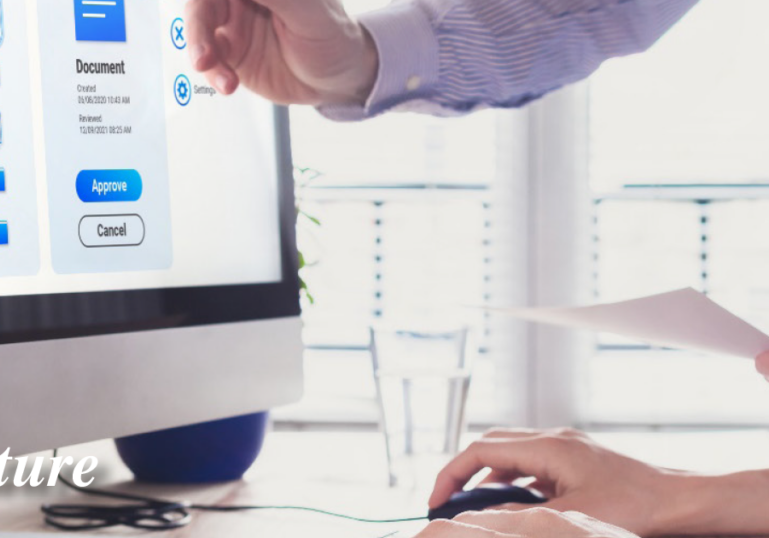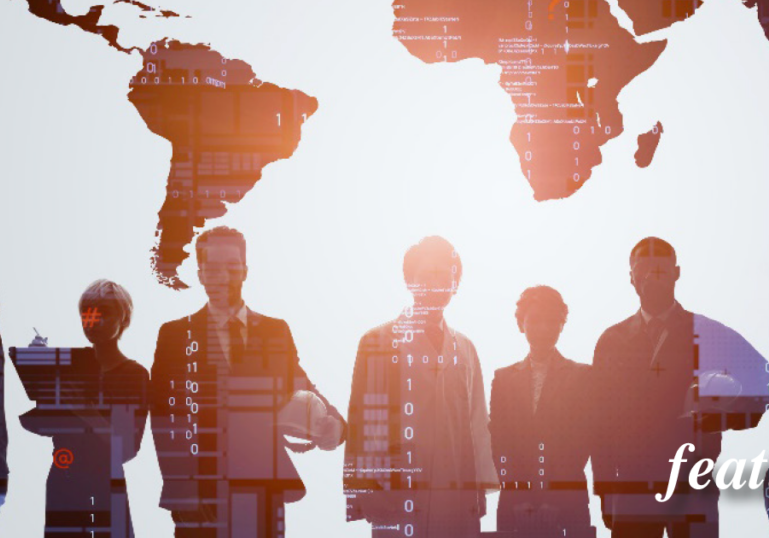The days of the digital employee experience being defined by antiquated intranet structures with content-heavy, function-light capabilities are just about behind us. And while fixing something broken in plain sight is always tempting, we should resist the urge. Rather, let’s take a step back and observe the fundamental misfit of most intranets relative to digital-age worker needs and emerging work practices. Like many outdated organizational frameworks, these are likely impractical as future state work platforms. Consider changing company purpose, the new value that business is trying to create, and the capabilities needed in future operating models to realize these goals. It should be clear that it’s time (past time, really) that we retire the intranet as we’ve known it and reset focus and investments to architect the open enterprise ecologies, horizontal and digitally enabled work processes, and intelligent worker experiences needed to win in the fast-approaching mid-2020s and beyond.
Evolution of the Cognitive Economy is the backdrop to Worker Experiences
As the disruptive forces associated with the Fourth Industrial Revolution and the accelerating drivers of post-COVID work are reshaping industries and changing work as we know it, organizations are responding with dramatically different ways of working in radically transformed operating models. Across the board, we’re rethinking the purpose of corporations and their role in society. We’re inverting the long-held organizational pyramid model and breaking down organizational siloes to develop the new capabilities associated with the rise of cognitive work practices in a world of increasingly automated industries. We’ve put culture at the center of these new work models along with our workers and their overall well-being. New structures are flexible and fluid, favoring individuals who contribute to collective intelligence and empowering autonomous teams led by a new breed of visionary and inspiring leaders who can navigate through chaos and learn through momentum.
__
Side quote: “To imagine and realize new ways to meet collective and individual needs, companies must tap into the full humanity of the people who work for them – the reward of which is sustained growth.”
The Imagination Machine, Martin Reeves and Jack Fuller
__
With this as our backdrop, we need to redesign our organizations and human work to ready for the new ‘Cognitive Economy’ and all its promises. We know that this economy is increasingly driven by intangibles – ideas, brand, knowledge, relationships, imagination — and new value creation is made possible by the ingenuity of people, aligned in clear purpose and equipped with the insights of digital assistants.
The digital employee experience exists here, in this space, at this critical and pivotal time. The opportunity to get it right goes well beyond the value of basic resource access, service catalogs, communications, and affronting systems with poorly designed processes. The experience opportunity is also the value of accelerating the path to new human work and enabling individuals and teams to connect parts, play with alternatives, and rethink constraints. The employee experience can enable the adoption of dramatically different AI-enhanced work practices – making human work safer, less routine, enriching, and creative. It can help to build connections, move vital knowledge relevant to each unique worker, and empower teams wherever their members are in the world. And the digital experience can adapt and learn, anticipating workers’ needs and being respectful of worker choices.
The faster we can set our sights on pursuing these experience possibilities, the sooner we can help the enterprise to reinvent itself with new mental models that advance financial, human, intellectual, and social capital.
Experiences in new digital Operating models
Today, business leaders are focused on a sequence of game-changing initiatives that create impact cumulatively by ensuring alignment at all levels of the organization centered around models of work that encapsulate speed, agility, efficiency, precision, and cognition.
Figure 1. Experiences informed in new Operating Models
Logical Design Solutions, Inc.
To create purposeful employee experiences, we will need to imagine this new organization in motion and anticipate people interacting and living there, with all relative structures and protocols, processes and practices, contexts and challenges, and relationships and exchanges. In this dynamic environment, experiences help people to engage, experiment, navigate, and adapt to their changing work and workplace ahead of critical curves. Emerging operating models require organizational capabilities that don’t reliably exist yet, and experiences serve as channels of change to building these new organizational assets and capabilities.
Experiences ensure the ever-changing business ecosystem, and all its resources is accessible, optimized, relevant, and rationalized for people (not by people). And experiences enable people to be in control and informed during peak transitions – confident and capable in the alternative chaos of constant change.
Experiences should create capacity for the organization and its people – such as when well-applied intelligent automation and advanced analytics automate routine tasks or inform insights that enable better decisions — freeing individuals, teams, or leaders to focus on other pressing challenges or higher-value opportunities.
__
Sidebar: Skills Needed in new Operating Models
- Design Mindset
- Social Intelligence
- Sensemaking
- Novel and Adaptive Thinking
- Cognitive Load Management
- Computational Thinking
- Transdisciplinary
- Virtual Collaboration
- Cross-cultural Competency
- New Media Literacy
Figure 2. Future Work Skills
__
People platforms in growing business ecosystems
The digital employee experience is the “street-level” view of the business ecosystem from the perspective of an individual worker. These are logical (often not singular) people platforms — peer-to-peer, democratic, networked, adaptive, omnichannel, with shared learnings – and they seamlessly leverage and present the assets of a growing suite of enterprise platforms, systems, data, knowledge, and tools in the ecosystem by contextualizing and integrating these assets into a powerful work platform “for one.”
__
Sidebar Quote: “Recognize that competitive advantage does not come from technological capabilities alone: it comes from an integrated set of capabilities, what you are able to create with those capabilities, and a culture that embraces change.”
Digital Business Transformation, How Companies Sustain Competitive Advantage from Now to Next
Nigel Vaz
__
As experience platforms become productized, they provide valuable acceleration, a technology upgrade path, and a suite of capabilities such as service management, communications with targeting and social capabilities, and content management. These are important experience-building blocks for all enterprises and possibly out-of-the-box solutions for organizations without significant business complexity or variability. In our experience, most of these platforms will be “one of many” in mid- to large organizations, with important issues to surface and resolve in business and architecture strategy prior to design and implementation.
Integration becomes an important issue. Rather than a back-end implementation challenge, integration shifts (along with other foundational concepts) to a front-end business, work, and people challenge that must be logically architected as a business design. Said another way — the underpinnings of the experience solution are business structures, and they need to support critical business operations without unexpected gaps. Here, too, sustainability is less about a technology upgrade path and more about managing critical success factors. These often include identifying when the redesign of complex work processes across functions and systems is needed prior to digitalization; the ability to define strategic and operational governance practices that work in global settings; and running an effective change management strategy to affect early adoption, build solution advocacy, and minimize disruption.
__
Sidebar quote: “Let’s remind ourselves of the task at hand: to design machines with a high degree of intelligence – so that they can help us with difficult problems – while ensuring that those machines never behave in ways that make us seriously unhappy.”
Human Compatible, Artificial Intelligence and the Problem of Control, Stuart Russell
__
Employee experiences, then, are the uber-product of many technologies coming together to “consumerize” the worker experience, with similar rigor and care afforded to the customer experience. Well done, worker experiences return a wide range of value to people and the business: not just efficiency and effectiveness, but productivity, wayfinding, risk mitigation, attention management, informed decision-making, engagement, ideation, and inspiration. As we plan and design experiences, we must look around the ecosystem to understand the value and readiness of assets in the context of worker needs and their relationships, and then across the range of possible value to design logically sound, business-scalable, usable-by-people experiences with profoundly impactful outcomes.
Related, as we bring more data and AI-powered capabilities into our ecosystems, it’s imperative that underlying business logic can be presented with transparency and in context to the worker and their tasks. We need to be cautious of the potential for bias in logic and the misinterpretation of data by people. And, as we proceed, we need to ensure that machine-generated guidance and advice in our experiences ultimately defers final judgement to our human workers.
As in our operating models, evolvability is a pillar idea in sustainability. “One and done” digital strategies and experience initiatives are unlikely to succeed over time, and evolution planning should start early and be maintained by the product team. Even minimal viable product (MVP) launches need aspirational roadmaps that depict a “from here to there” plan of iteration and innovation. Roadmaps stage a rational set of “now-soon-later” foundational and functional capabilities based on value, priority, operational readiness, and technical complexity. Leapfrog and experimental methodologies run in parallel.
While these plans and prototypes are intended to be adaptable to continual change and lessons learned, they importantly always imagine and pursue a newly connected and innovative world of work, much different from where an organization is today. Roadmaps should ensure experience investments maintain a “north star” focus on strategy and transformation goals.
Experiences as scalable design systems
To create sustainable experiences, we need to design in frameworks with building- block principles, structures, patterns, omni-channel strategies, smart components and parts, bi-directional data integrations, and the architectural agreements needed to scale and extend the experience and its capabilities efficiently and with the least amount of waste over time.
Essential concepts from UX, systems thinking, scenario planning, and enterprise architecture are combined to formulate design systems, which anticipate repeating and common forms of human understanding and behavior and generalize them into reusable interaction patterns and design standards. When realized in experiences, design systems create familiarity and consistency for users while accelerating and increasing adoption. For experience stewards and owners, design systems offer economy and reuse, acceleration, and extensibility.
Conceptual Modeling is Key
Models such as the employee lifecycle, career journeys, culture models, future work models, and other organizational change models often provide important input for experience strategy and design, assuming these models are future-focused, endorsed by senior stakeholders, and tested with people.
Below, we show an example of an employee lifecycle (see figure 3) that may align to the priorities of a new organizational operating model. With employee fulfillment as the overarching goal, the employee lifecycle suggests the worker realizes their true potential by revealing deeply satisfying experiences with moments that matter. These moments are not only imbued with a sense of purpose, but also promote ownership, durable network building, attainment of deep trust and credibility, and clear recognition for a job well done. Ultimately, the employee either remains with the organization and finds their next challenge through an outstanding internal mobility program, or transitions to alumni and becomes a brand ambassador with a legitimate sense of fulfilment for a job well done.
Armed with these ideas and relevant worker research, we can imagine and design experiences that enable these transformative journeys.
Figure 3. Example of Employee Lifecycle
Logical Design Solutions, Inc.
Personas developed in experience strategy reveal relevant worker segments, their attributes, pain points, preferences, and variability needs for experiences to be highly relevant and, over time, adaptive to worker behavior. One common segment with unique experiential needs is that of people managers. Like the employee lifecycle, we may develop unique models to inform experience design, such as the Manager’s Role in the New Employee Lifecycle, as shown in Figure 4, below. Again, we’ll design for the scenarios implicit in these models, and iterate/validate through “art of the possible” workshops and discussions.
Figure 4. Example of Manager’s Role in the Employee Lifecycle
Logical Design Solutions, Inc.
In Summary: People Strategies & Experiences
As human-machine work allocation becomes integral to organizational design, the worker becomes central to the organizational ecosystem through the evolution of new work practices and social contracts that accelerate the transformation of industry. Organizations will design, build, and continuously improve the workplace, with people strategy and employee experience at the core. New value creation will become a key purpose of the experience, while speed, quality and value will supersede a prior focus on time, scope, and cost.
Work design takes on new scope and complexity as organizations leverage the opportunity to create purposeful and meaningful human work to meet productivity and growth opportunities, and to attract and retain the very best talent with the most interesting work and inspiring environments.
Companies will redesign systems and structures to support new operating and work models, and employees will help to design the fluid and flexible human “jobs” needed therein. These new work models will be designed in tandem with machine learning technologies that will remove routine and redundant work, along with complex analytic analysis, which should, in turn, raise the quality and value of human contribution, and free people to refocus on counterfactual problem-solving.
It is our experience that a powerful combination of factors, including leading with purpose and empathy, empowering employees to create unique and imaginative goals, and constant adaptation based on individual employee needs all contribute to a sustainable employee experience, and set the bar for the digital experiences we aspire to design. By authentically tailoring the everyday work environment to facilitate the achievement of personalized goals, organizations can elevate performance and kindle productive energies that all too often lie dormant in siloed traditional settings.
By designing sustainable business and people experiences in these holistic organizational, work, and social contexts, enterprises will survive and thrive in a new economy where massive changes still lie ahead. Developing agile approaches that achieve both scale and responsiveness will dovetail with sustainable business practices and the activation of new business models. These will funnel through the operating model to both job and work design, and to a fulfilling employee experience that embraces large scale digital business transformation aligned to the economic model of the business, while at the same time cultivating the cultures, mindsets, and behavioral changes necessary to succeed in the 2020s.
